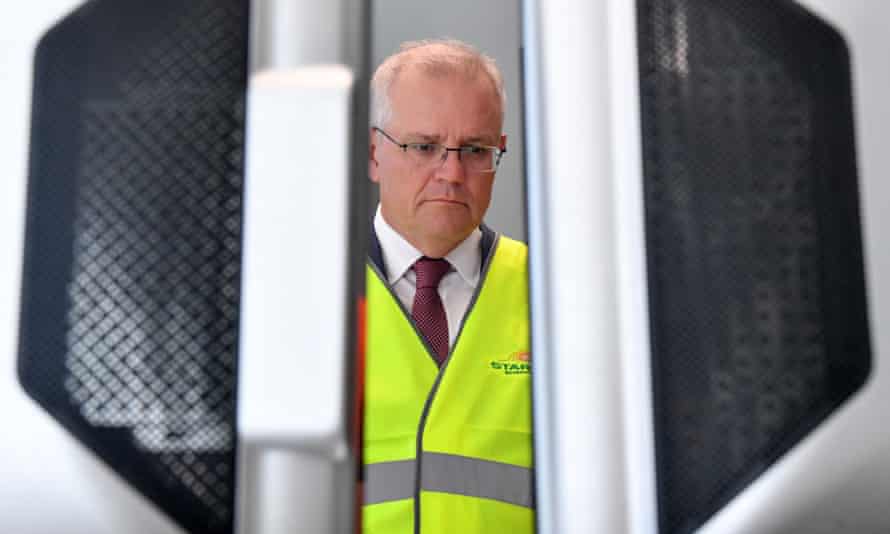Extract from The Guardian
Experts’ assessment comes on eve of US-hosted climate summit pressing countries for bigger commitments and deeper cuts to emissions

Last modified on Wed 21 Apr 2021 19.52 AEST
The Morrison government has been warned it needs to massively increase investment in clean technology if it is serious about its “technology, not taxes” climate policy after promising $540m for “clean” hydrogen and carbon capture programs.
Scott Morrison visited the New South Wales central coast on Wednesday to promise $275m for hydrogen hubs over five years and $263.7m for carbon capture and storage (CCS) projects and hubs over the next decade.
It comes ahead of a virtual climate summit hosted by the US president, Joe Biden, on Thursday, where countries are being asked to promise greater commitments and much deeper cuts in greenhouse gas emissions this decade to give the world a chance of meeting the goals of the Paris agreement.
The US and Japan are expected to announce targets to roughly halve their emissions by 2030. Britain on Tuesday pledged a 78% cut below 1990 emissions levels by 2035.
Morrison said the Australian funding was for “world-leading projects” that would support manufacturing and industry and cut greenhouse gas emissions.
Harry Guinness, a former Liberal adviser and chief executive of the centre-right thinktank the Blueprint Institute, said the US was planning to spend about 35 times what Australia allocated in the last federal budget on green stimulus, and the government would need to commit to serious finance if Australia was to make a transition to net zero by 2050 as Scott Morrison has said is his preference.
“Our friends and allies are going to want to see tangible commitments. They’ve been quite clear about that, it’s no mystery,” Guinness said. “If we are in the game of bringing technologies down the cost curve we need finance and incentives, including pricing carbon. Actions speak louder than words.”
Tony Wood, the Grattan Institute’s energy program director, said there was little detail in what the government had announced on Wednesday, making it hard to assess, but that Australia was spending significantly less on hydrogen than some other countries.
He said Australia was also offering support for hydrogen made with fossil fuels where others were backing “green hydrogen” made with renewable energy only.
“I don’t see any evidence that Australia has developed positions that are leading the world,” he said.
The government said it would now support five regional hydrogen hubs, following the announcement of $70.2m for the first hub in last year’s budget. It said it expected to announce the hubs next year, with potential sites in Tasmania’s Bell Bay, the Pilbara, Gladstone, the Latrobe and Hunter valleys, the Eyre Peninsula in South Australia and Darwin. Its goal is to help reduce the cost of producing hydrogen to $2 a kilogram.
Announcing the funding on Wednesday, Morrison said hydrogen was “zero emissions gas”.
The Greens said as the government planned to support hydrogen made with fossil fuels as well as renewable energy its commitment was “just more cash for coal and gas”. The party’s leader, Adam Bandt, said it paled next to multibillio-dollar green hydrogen commitments by other countries including South Korea, Germany, Spain, France, Japan and Saudi Arabia.
“This government’s obsession with coal and gas is about to cost Australia as other countries invest heavily in green hydrogen, giving them the edge as future markets open up,” Bandt said. “With all our wind and sunshine, this is Australia’s competitive advantage to seize, but it is being lost.”
On carbon capture and storage, the government said the funding would support research, development and deployment. It nominated potential CCS hub locations at Moomba in South Australia, Gladstone, Darwin, NSW’s Darling Basin and sites across Western Australia. It said a $50m carbon capture storage and utilisation fund announced last year had been massively oversubscribed, receiving 71 applications, with successful projects due to be announced later this year
Richie Merzian, the Australia Institute’s climate and energy program director, said it appeared the government was “once again using climate action to support fossil fuel companies”. He said that under current commitments it was possible by 2030 the US would have halved its emissions and the UK cut its emissions by two-thirds but Australia was sitting on a 26% cut while still subsidising fossil fuels.
He said Australia had committed $1.3bn to CCS development and had only “one problematic project” – Chevron’s Gorgon liquefied natural gas development, which was delayed for years before coming online – to show for it.
“What they’ve announced is future projects for the auditor general to investigate,” Merzian said. “Carbon capture and storage has been a global failure and a marketing tool to extend the social licence of fossils with the promise of burying emissions. The only credible solution to climate change is to phase out fossil fuels – anything else is window dressing.”
Wood said people had been “throwing a lot of money” at CCS for 20 years for not much result. He said it could help in industries in which there were few solutions, such as cement, but was likely to play a support rather than a leading role in emissions cuts.
Guinness said it was good Morrison was “moving in the right direction” but Australia needed to make comparable commitments to the US and other countries and, ahead of Biden’s summit, set targets for 2030 and 2040 that would set the country up to meet the “net-zero challenge”.
“Other nations will be focused on that, and the price of admission [to global climate meetings] is quickly going up.”
No comments:
Post a Comment